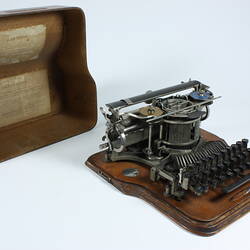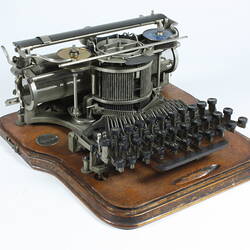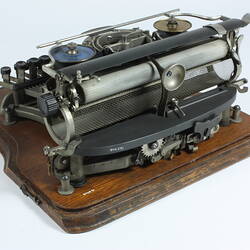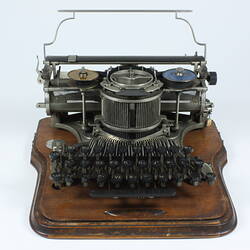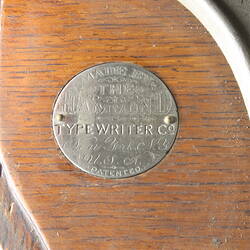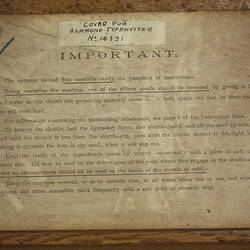Summary
Typewriter of the typewheel class manufactured by the Hammond Typewriter Company of New York, USA. The design was invented by Jame Bartlett Hammond and was first patented in 1880. The Model No. 1 came on the market in 1884. This machine is a Model No. 2 which was introduced in 1893 or 1895 and superseded in 1905.
In this typewriter the characters are carried on a curved strip or shuttle which is attached to a swinging wheel. Pressing a key rotates the wheel and shuttle to bring the selected character into position opposite a hammer. The spring-driven hammer then strikes the paper against the character and ribbon. Because the printed impression of each character was controlled by the hammer spring and not by the force with which the operator struck the key, the Hammond typewriters had the reputation of producing very even looking print.
Different shuttles were available, allowing changes in fonts and languages. In some models two shuttles could be attached to the typewheel at the same time so that fonts could be changed simply by rotating the typewheel through 180 degrees on its spindle. Hammond typewriters were available with either a curved keyboard (known as the 'Ideal'), or a straight keyboard (known as the 'Universal'), as with this machine.
Physical Description
Wooden base. Three-row QWERTY keyboard. Type ribbon carried between spools on vertical axes. Sector typewheel rotates within metal sleeve. Wooden cover fits over typewriter.
More Information
-
Collecting Areas
-
Acquisition Information
Purchase
-
Manufacturer
Hammond Typewriter Company, New York, New York, United States of America, circa 1900
-
Inscriptions
Inscribed on disc on left-hand side of baseboard: 'MADE BY / THE / HAMMOND TYPEWRITER CO. / New York, N.Y. / U.S.A. / PATENTED' Serial number inscribed on right-hand side rear of frame: '32615' On front of wooden cover : 'Hammond'
-
Classification
-
Category
-
Discipline
-
Type of item
-
Overall Dimensions
360 mm (Width), 372 mm (Depth), 178 mm (Height)
Dimensions of typewriter alone without cover.
-
Overall Dimensions
360 mm (Width), 372 mm (Depth), 183 mm (Height)
Dimensions of typewriter with cover.
-
Keywords

